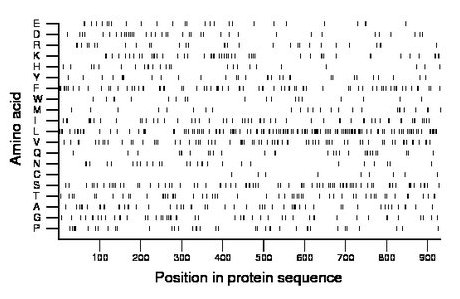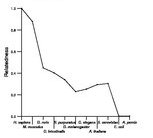
| Name: PIGN | Sequence: fasta or formatted (931aa) | NCBI GI: 29029537 | |
|
Description: phosphatidylinositol glycan anchor biosynthesis, class N
|
Referenced in:
| ||
Other entries for this name:
alt mRNA [931aa] phosphatidylinositol glycan anchor biosynthesis, class N | |||
|
Composition:

Amino acid Percentage Count Longest homopolymer A alanine 5.6 52 2 C cysteine 1.1 10 2 D aspartate 4.3 40 2 E glutamate 3.1 29 2 F phenylalanine 8.4 78 3 G glycine 5.3 49 1 H histidine 2.8 26 2 I isoleucine 5.9 55 2 K lysine 5.3 49 2 L leucine 14.2 132 3 M methionine 2.9 27 2 N asparagine 3.0 28 2 P proline 4.2 39 3 Q glutamine 3.1 29 2 R arginine 3.2 30 2 S serine 8.4 78 2 T threonine 5.7 53 2 V valine 8.1 75 2 W tryptophan 2.0 19 1 Y tyrosine 3.5 33 2 |
Comparative genomics:
Search single species RefSeq proteins at NCBI
Search summary 
Figure data | ||
Related human proteins:Protein Relative score Description Self-match 1.000 phosphatidylinositol glycan anchor biosynthesis, cla... PIGN 1.000 phosphatidylinositol glycan anchor biosynthesis, clas... PIGG 0.021 phosphatidylinositol glycan anchor biosynthesis, cl... PIGG 0.021 phosphatidylinositol glycan anchor biosynthesis, cl... PIGO 0.014 phosphatidylinositol glycan anchor biosynthesis, cla... PIGO 0.014 phosphatidylinositol glycan anchor biosynthesis, cla... ENPP4 0.010 ectonucleotide pyrophosphatase/phosphodiesterase 4 (p... ENPP6 0.009 ectonucleotide pyrophosphatase/phosphodiesterase 6 [... LOC100289996 0.005 PREDICTED: hypothetical protein XP_002347212 LOC100287396 0.005 PREDICTED: hypothetical protein XP_002343076 ARHGAP5 0.004 Rho GTPase activating protein 5 isoform a ARHGAP5 0.004 Rho GTPase activating protein 5 isoform b SLC6A12 0.004 solute carrier family 6 (neurotransmitter transport... SLC6A12 0.004 solute carrier family 6 (neurotransmitter transport... SLC6A12 0.004 solute carrier family 6 (neurotransmitter transport... ENPP7 0.004 ectonucleotide pyrophosphatase/phosphodiesterase 7 [... GDAP2 0.003 ganglioside induced differentiation associated prot... CACNG1 0.003 voltage-dependent calcium channel gamma-1 subunit [Ho...Human BLASTP results (used to prepare the table) | |||
Gene descriptions are from NCBI RefSeq. Search results were obtained with NCBI BLAST and RefSeq entries. When identical proteins are present, the self-match may not be listed first in BLASTP output. In such cases, the table above has been reordered to place it first.
See About the Figures for the scoring system used in the figure above right. The same scoring system was used in the table of BLASTP results.
Guide to the Human Genome
Copyright © 2010 by Stewart Scherer. All rights reserved.
